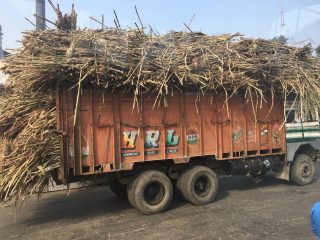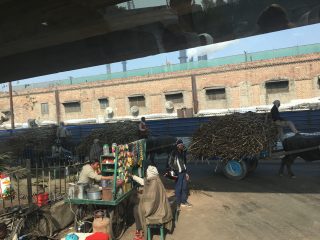While in India, we had a unique opportunity to tour a sugar mill that was established over 85 years ago in 1932. The sugar mill is one of the largest of the 30 in the area, intaking 13,500 tons of sugarcane a day from roughly 40,000 farmers up to 50 km away. Fifty kilometers may not sound like a lot, but when the sugarcane is being hauled by bulls or packed so high it may topple over, 50 km can be much more intimidating.
Once the mature cane is harvested, the farmers must be sure to get it to the mill within 24 hours. This ensures that the maximum sugar content can be extracted from the cane. After it reaches the mill, the cane is weighed and loaded onto a belt where it is taken to be crushed.
The cane is crushed so the maximum amount of “juice”can be taken from the cane. Water is added to create a slurry looking mush, and then the impurities are allowed to settle out.
The juice is further processed and sent through a series of impressive operations. Water is evaporated at exactly 60C and the sugar that is left behind falls into the device seen in the next clip.
Afterwards, the sugar travels to another section of the mill where it will be bagged and exported to over 100 countries, multinational companies such as Coca-Cola, as well as hotels and other municipalities.
The process of raising sugarcane to maturity and refining it into the sugar we all know and love is a highly water intensive process. The mill has taken measures to ensure that even in the arid climate, surrounding farmers can rely on them for some irrigation water. The water used throughout the sugar milling process is condensed, treated,and sent out to be used.
While we were touring the mill, it was in the middle of its ‘on’ season. Because sugarcane does not grow year round, the mill works on a 6 month on, 6 month off basis. However, because the plant and the price of sugar is secured by the government, they are not allowed to stop production until a certain quota is met, regardless of the profits by the mill or the season. This encourages the workers and managers of the mill to be as productive and efficient as possible while the crop is in season.
Even though the mill was buzzing with workers and farmers, they took the time to show us around and explain each individual aspect in the process. Our group was consistently amazed at the emphasis on hospitality, and we were grateful for this wonderful hands-on learning experience.

